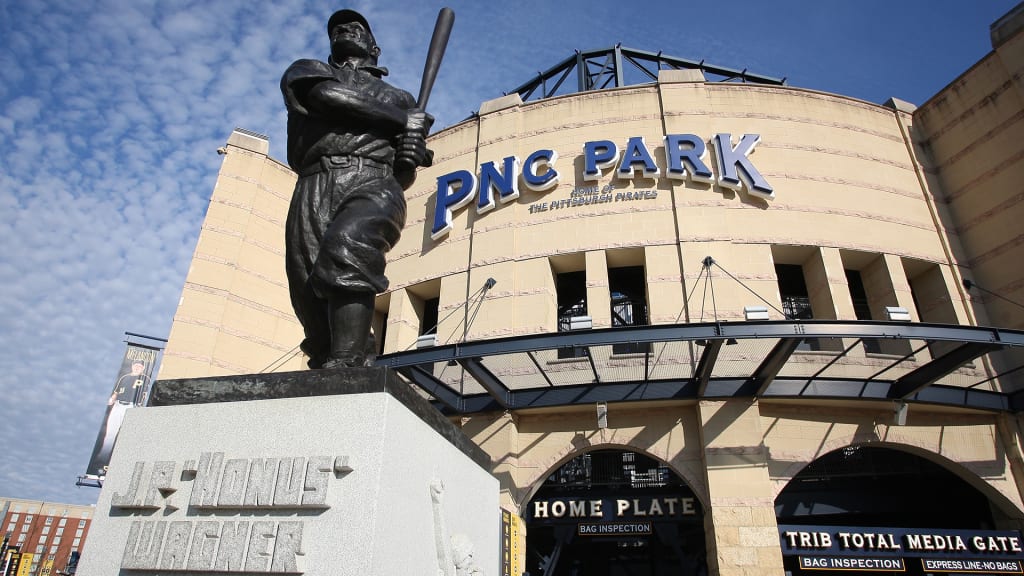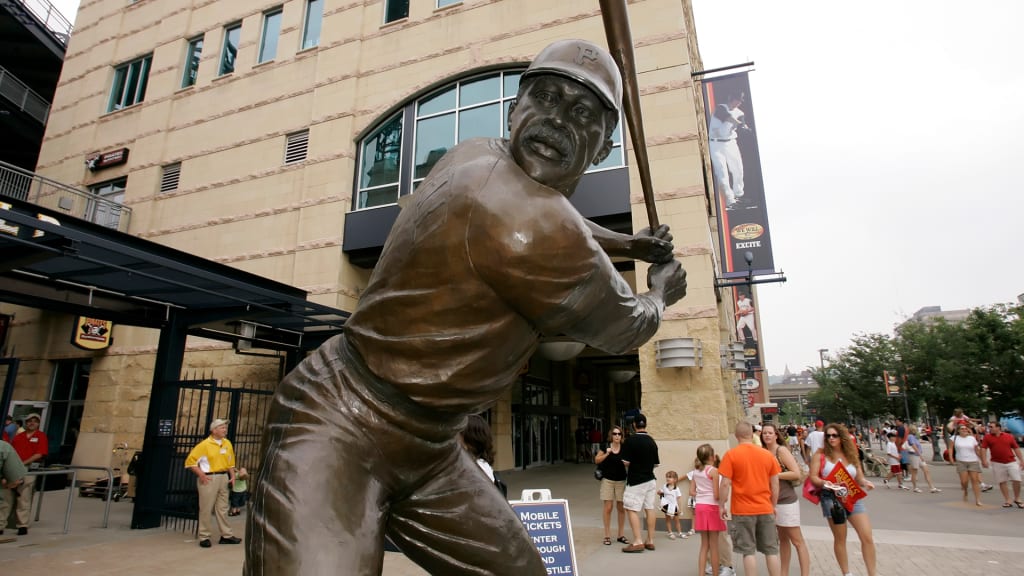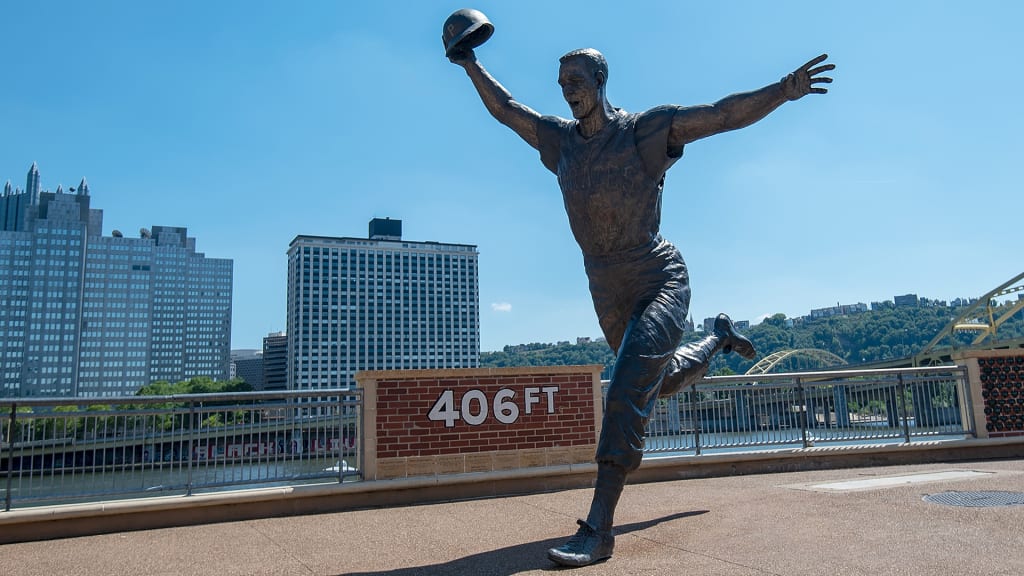
PITTSBURGH -- They¡¯ve been immortalized in Cooperstown and in the memories of baseball fans. They are also an essential part of the experience at Pittsburgh¡¯s beautiful PNC Park, as their bronze likenesses surround the ballpark on the north shore of the Allegheny River.
Honus Wagner, the inaugural-class Hall of Famer and one of the greatest players in Major League history. Roberto Clemente, the Hall of Fame player and humanitarian beloved everywhere from Pittsburgh to Puerto Rico. Willie Stargell, the iconic slugger known for bashing home runs and hanging out ¡°Stargell stars.¡± And Bill Mazeroski, the defensive whiz ironically best remembered for hitting a home run that stands alone in history.
What¡¯s the story behind the statues of those four Pirates legends?
Honus Wagner
¡°The Flying Dutchman¡± has stood in statue form in three locations associated with the Pirates since it was first dedicated on April 30, 1955.
The statue was originally located in Schenley Park, just beyond the left-field fence of Forbes Field. It was moved to Three Rivers Stadium, outside Gate C, on July 21, 1972. Now, Wagner stands guard in front of the home-plate entrance at PNC Park on the corner of General Robinson Street and Mazeroski Way.
During the initial dedication of the statue in 1955, Commissioner Ford C. Frick said, ¡°Honus Wagner as an individual contributed as much as any man who ever lived in baseball. I am proud for Honus, I am proud for baseball, and proud of Pittsburgh in recognizing the contribution Honus made to the game.¡±
According to the Pirates, Wagner¡¯s statue ¨C created by Frank Vittor -- was sponsored by the Pittsburgh Professional Baseball Association ¡°as a lasting tribute to his character and abilities.¡± The group of present and former players received contributions ¨C ranging from $1 to $1,000 ¨C from thousands of individuals, organizations and foundations, and the names of all those contributors were inscribed on one roll and put in a stainless steel, hermetically sealed tube placed inside the statue.
Roberto Clemente
Like Wagner¡¯s statue, the bronze likeness of Clemente moved to its current home outside PNC Park. It was originally erected outside Gate A at Three Rivers Stadium, where it was dedicated on July 8, 1994, to begin All-Star Week in Pittsburgh.
Now, the statue that depicts Clemente dropping his bat, watching a ball in flight and striding out of the box stands outside PNC Park¡¯s center-field gate, putting ¡°The Great One¡± between the ballpark and the bridge named in his honor with downtown Pittsburgh¡¯s skyline looming behind him in the distance.

The 12-foot bronze statue was sculpted by Susan Wagner, while L.D. Astorino & Associates Ltd. served as the architect of the project. The project cost about $200,000, all of which came from donations. The details go beyond just the image of No. 21, too. The base is black granite and stainless steel with a diamond set in the center. There are glass blocks representing first, second and third base, and underneath the glass is dirt from Clemente¡¯s native Puerto Rico, Forbes Field and Three Rivers Stadium.
Around the diamond, set in steel, is a timeline of Clemente¡¯s life: 15 inscriptions running counter-clockwise from home plate to near third base, all recounting career highlights. There is space for a 16th inscription, according to the Pirates, but it remains empty as ¡°a reflection of the incomplete circle of Roberto Clemente¡¯s life.¡±
Willie Stargell
Stargell¡¯s larger-than-life legacy with the Pirates is appropriately commemorated outside the left-field gate at PNC Park, where the club¡¯s all-time home run leader is displayed in his left-handed batting stance while wearing his No. 8 jersey. The statue of ¡°Pops¡± stands along Federal Street, just down the sidewalk from his former teammate Clemente.
The Pirates announced on Sept. 29, 2000, that they would unveil a statue outside PNC Park before the club began playing in the new ballpark. It was also created by Wagner, who studied old photographs and video of Stargell along with vintage bats and Pittsburgh uniforms. Sadly, Stargell was unable to attend the dedication ceremony on April 7, 2001, and he passed away early on April 9, 2001, when the Pirates hosted their first game at PNC Park.

Among those who attended the dedication ceremony: former Pirates Chuck Tanner and Nellie Briles and Vera Clemente and sons Luis and Roberto Jr. According to the Pittsburgh Post-Gazette, Tanner saw the statue and exclaimed, "That's just how he held the bat!"
The base displays ¡°Stargell stars,¡± the recognition handed out by Stargell toward the end of his 21-year career with the Pirates. The 12-foot bronze statue of the Hall of Fame slugger features a Stargell quote at its base: ¡°Last night, coming in from the airport, we came through the tunnel and the city opened up its arms and I felt at home.¡±
Bill Mazeroski
A month before the Pirates celebrated the 50th anniversary of their victory in the 1960 World Series, a Fall Classic capped by Mazeroski¡¯s Game 7 walk-off homer, the club unveiled a 12-foot bronze statue of the Hall of Fame second baseman on Sept. 5, 2010, while ¡°Maz¡± celebrated his 74th birthday.

The statue was dedicated by Pirates chairman Bob Nutting and revealed by Mazeroski¡¯s two sons, Darren and David; his grandson, Billy; and former Pittsburgh teammates Bob Friend, Dick Groat, Roy Face and Bill Virdon.
"It's a rare opportunity when you have the chance to honor a man like Bill Mazeroski on a level equal to what he represents, both as a Pittsburgh Pirate and as a member of the Pittsburgh community,¡± Nutting said in 2010. ¡°Bill has set a high bar for humility and grace that we should all strive to reach. I am especially proud that we have been able to not only recognize Bill's Hall of Fame career, but also capture the greatest moment in Pittsburgh sports history and enshrine it forever. Now our fans will have a special place outside of PNC Park to share Bill's inspirational story for generations to come."
The statue depicting Mazeroski, helmet in hand and arms outstretched as he rounds the bases following his game-winning blast, is located at the end of Mazeroski Way near the right-field entrance of PNC Park. He remains the only player in Major League history to hit a walk-off homer in Game 7 of a World Series, which he did against the Yankees¡¯ Ralph Terry on Oct. 13, 1960, at Forbes Field.
